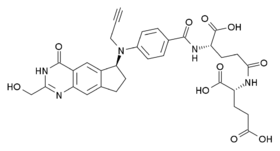ONX-0801
 | |
| Clinical data | |
|---|---|
| ATC code |
|
| Identifiers | |
| |
| CAS Number |
|
| PubChem CID | |
| Chemical and physical data | |
| Formula | C33H31N5O10 |
| Molar mass | 647.631 g/mol |
| 3D model (JSmol) | |
| |
ONX-0801 (BGC 945) is an experimental drug that has been developed to target ovarian cancer.[1] It is an alpha-folate receptor mediated thymidylate synthase inhibitor.[2][3]
ONX-0801 was originally developed by BTG and the Institute of Cancer Research in the UK, and subsequently licensed to Onyx Pharmaceuticals for clinical development. It is designed to selectively target tumour tissues of certain kinds of cancer.[4] It is poorly absorbed into most cells, but is actively transported by an enzyme α-folate receptor (FRα), which is usually only expressed at low levels in the apical membrane of some specialised tissues, but is expressed at much higher levels in some subtypes of ovarian cancer. This causes the drug to accumulate selectively in tumour tissues, while healthy tissues are only exposed to a much lower concentration.[5][6][7]
In 2017, it received press coverage following the successful completion of a Phase I clinical trial.[8][9][10]
References
- ↑ "Ovarian cancer drug delivers 'very promising' results in early trial". The Institute of Cancer Research, London. 3 June 2017. Retrieved 2017-06-03.
- ↑ "A Phase I trial of ONX-0801". Health Research Authority. 19 July 2013. Retrieved 2017-06-03.
- ↑ Jarmula A. Antifolate inhibitors of thymidylate synthase as anticancer drugs. Mini Reviews in Medicinal Chemistry 10.13 (2010): 1211-1222. PMID 20854257
- ↑ Gibbs DD, Theti DS, Wood N, Green M, Raynaud F, Valenti M, Forster MD, Mitchell F, Bavetsias V, Henderson E, Jackman AL. BGC 945, a novel tumor-selective thymidylate synthase inhibitor targeted to alpha-folate receptor-overexpressing tumors. Cancer Res. 2005 Dec 15;65(24):11721-8. PMID 16357184
- ↑ Ng C, et al. Efficacy and tolerability of the thymidylate synthase (TS) inhibitor, BGC 945 is mediated through its selective uptake via the α-folate receptor (α-FR) in IGROV-1 human tumor xenografts. Cancer Res May 1, 2008 (68) (9 Supplement): 3289.
- ↑ Ng CHM, Jackman AL. Potential for α-Folate Receptor-Targeted Treatment for Ovarian Cancer. Emerging Therapeutic Targets in Ovarian Cancer. Springer New York, 2011. 245-258.
- ↑ Tochowicz A, Dalziel S, Eidam O, O'Connell JD 3rd, Griner S, Finer-Moore JS, Stroud RM. Development and binding mode assessment of N-[4-[2-propyn-1-yl[(6S)-4,6,7,8-tetrahydro-2-(hydroxymethyl)-4-oxo-3H-cyclopenta[g]quinazolin-6-yl]amino]benzoyl]-l-γ-glutamyl-D-glutamic acid (BGC 945), a novel thymidylate synthase inhibitor that targets tumor cells. J Med Chem. 2013 Jul 11;56(13):5446-55. doi: 10.1021/jm400490e PMID 23710599
- ↑ Warry, Richard (2017-06-03). "Drug shrinks ovarian tumours in early trial". BBC News. Retrieved 2017-06-03.
- ↑ "Researchers hail biggest breakthrough in advanced ovarian cancer for a decade". The Independent. 2017-06-02. Retrieved 2017-06-03.
- ↑ Banerji U, et al. An investigator-initiated phase I study of ONX-0801, a first-in-class alpha folate receptor targeted, small molecule thymidylate synthase inhibitor in solid tumors. J Clin Oncol 35, 2017 (suppl; abstr 2503)